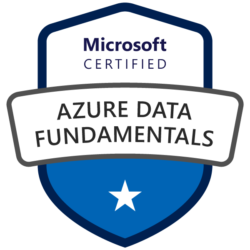Motivating DP-900 : Azure Data Fundamentals
Data Engineering is one of the fastest growing career opportunity for people aspiring a career in machine learning and AI. This growth is because of the explosion of cloud computing. And, Microsoft Azure is one of the leading cloud providers. Hence, Azure Data Engineers are increasingly sought after.
Hence, to breakthrough a career in Azure Data Engineering, a certification may help. Following are the certifications that one may take in the space of Data Engineering on Azure:
- DP-900 : Azure Data Fundamentals.
- DP-200/DP-201: Azure Data Engineer Associate.
Although these certifications can be pursued in any order, it is always desirable to get the fundamentals right. Azure Data Fundamentals is the perfect step for an aspirant to start with their Data Engineering/Data Analytics. Let’s walkthrough the modules:
1. Explore core data concepts
This module is a 10000 ft view of what’s about to come. It introduces core concepts of data solutions or information systems at large. It introduces types of data storage like relational/non relational, etc. Furthermore, it introduces data processing paradigms like batch processing and stream processing. Finally, it leaves you with a taste of data analytics.
Refer to this link in order to dive deeper.
2. Explore relational data in Azure
Relational databases have been a bedrock of information systems for a long time. Inspired from the tabular data structure, they store data in form of rows and columns. In fact, relational databases have turned into a scientific and engineering discipline. Thus, a variety of database management systems have made it to the market viz. Oracle, Microsoft SQL Server, MySQL, etc.
But, traditional on premises DBMS have a cost overhead in terms of setup and maintenance. These challenges have been addressed by cloud providers. In Microsoft Azure, Databases come in two flavours i.e. IaaS (Infrastructure as a service) or PaaS(platform as a service). This module introduces both the varieties. You will study services like SQL Server on a VM, Azure SQL Database, PostgreSQL, Maria DB and MySQL.
Furthermore, you will have two sets of hands-on labs:
- To provision some of these services.
- To query data from these services.
Refer to this link in order to dive deeper.
3. Explore non-relational data in Azure
We know that not all data can be stored as tables. Hence, a new family of databases came up viz. non-relational data. These data stores can deal with semi-structured and unstructured data (relational data is also called structured data).
To store semi-structured data, there are a variety of databases called as No-SQL databases. A few of them are Document Database, Graph Database, Column family DB, key-value stores, etc. As far as unstructured data is concerned, we have object stores and data lake stores.
In Microsoft Azure, we have Cosmos DB for all the No SQL DB workloads. Besides, we have Azure Storage account for object stores like Azure Blob Store and Azure Data Lake store. This module will walk through various services like Azure Cosmos DB, Azure Blob, Table store, File Storage, etc.
Furthermore, you will have two sets of hands-on labs:
- To provision some of these services.
- To extract data from these services.
Refer to this link in order to dive deeper.
4.Explore modern data warehouse analytics in Azure
A fundamental question; why do we build the above datastores? Why do we build information systems? The simple answer is Data Driven Decision Making. We build data warehouses, datamarts, analytical stores in order to enhance business decisions using data. This brings us to the last module viz. Data warehousing and Analytics.
This module starts with an introduction to data warehousing concepts and Azure data services for the same. Next, it deals with data ingestion services like Azure Data Factory. It then moves to Data Transformation services like Azure Databricks, HDInsight and Azure Synapse Analytics etc. It ends with the data visualization layer viz. Power BI.
Refer to this link in order to dive deeper.
Concluding tips for DP-900
The aim of this article is not being a study guide for DP-900. However, here are some tips:
- Focus on labs.
- Learn some DBMS and Data warehousing concepts.
All the best to everyone who aspires to take DP-900.
Also read: Overview Of The Exam AI-900 : Azure AI Fundamentals

